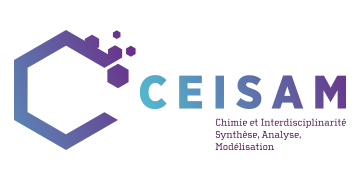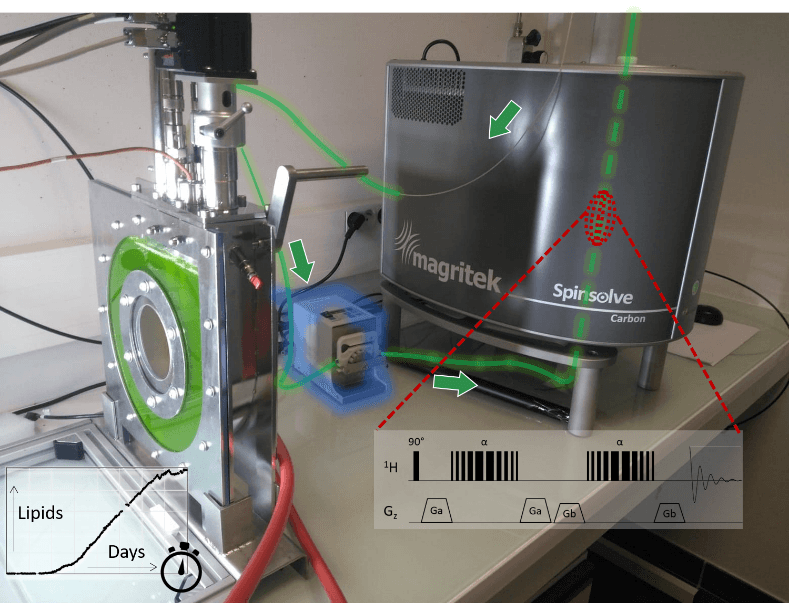Cet axe de recherche récent a été initié en 2015 à partir des développements de l'équipe en RMN multidimensionnelle rapide, appliqués au suivi en temps réel de transformations (bio)chimiques complexes. Les milieux réactionnels sont des mélanges complexes hors d’équilibre qui nécessitent des séquences d’impulsions adaptées, compatibles avec l’analyse en flux. Ces méthodes sont développées à la fois à haut champ et sur des spectromètres de paillasse.
À haut champ, une configuration expérimentale unique associant un tube en flux à un équipement de micro-imagerie est également disponible.
Deux des spectromètres de paillasse de l'équipe sont également munis d’un système en flux continu. Les applications ciblées comprennent le suivi et le contrôle de réactions de synthèse organique en flux intelligent, en collaboration avec l’équipe CORAIL. L'équipe explore également le suivi de bioprocédés tels que les cultures de microalgues ou les processus alimentaires induits par voie enzymatique.
Current team members: Nour El Sabbagh, Benoît Charrier, Jean-Nicolas Dumez, Patrick Giraudeau, Jonathan Farjon*,
Past team members: Dylan Bouillaud
Collaborations: Olivier Goncalves (GEPEA, Univ. Nantes), Julien Legros (COBRA, Rouen), Mireia Rodriguez-Zubiri and François-Xavier Felpin (CEISAM, Univ. Nantes), Mecit Oztop (Middle East Technical University, Turkey)

NMR is ideally suited for the online, real-time monitoring of (bio)chemical processes, but it can be limited by size, cost and accessibility considerations that make high-field NMR incompatible with the environment where the targeted processes take place, such as fume hoods or production sites. In this context, we are exploring the potential of benchtop NMR for the online monitoring and control of such processes. In order to circumvent the limitations inherent to low magnetic field (low sensitivity and resolution), we are adapting pulse sequences akin to those developed at high field, thanks to state-of-the-art benchtop spectrometers equipped with a gradient coil and including pulse sequence programming capabilities.
In particular, we have implemented solvent suppression and ultrafast 2D NMR pulse sequences suited to flow measurements. In collaboration with synthetic chemistry groups, we explore their potential for the online monitoring of catalytic reactions, and we use such experiments as an online detector in flow chemistry settings, including intelligent flow experiments where the NMR data are analyzed automatically in real time to optimize the reaction. We are also exploring the potential of benchtop NMR for the monitoring of bioprocesses.
Key References:
- B. Gouilleux, S. Akoka, P. Giraudeau, Gradient-based solvent suppression methods on a benchtop spectrometer, Magn. Reson. Chem. 55, 91 (2017)
- B. Picard, B. Gouilleux, T. Lebleu, J. Maddaluno, I. Chataigner, M. Penhoat, F.X. Felpin, P. Giraudeau, J. Legros, Oxidative Neutralization of Mustard-Gas Simulants in an On-Board Flow Device with In-Line NMR Monitoring, Angew. Chem. Int. Ed. 56, 7568 (2017)
- D. Bouillaud, J. Farjon, O. Gonçalves, P. Giraudeau, Benchtop NMR for the monitoring of bioprocesses, Magn. Reson. Chem. 57, 794 (2019)
- D. Bouillaud, V. Heredia, T. Castaing-Cordier, D. Drouin, B. Charrier, O. Gonçalves, J. Farjon, P. Giraudeau, Benchtop flow NMR spectroscopy as an online device for the in vivo monitoring of lipid accumulation in microalgae, Alg. Res., 43, 101624 (2019)
- D. Bouillaud, D. Drouin, B. Charrier, C. Jacquemmoz, J. Farjon, P. Giraudeau, O. Gonçalves, Using benchtop NMR spectroscopy as an online non-invasive in vivo lipid sensor for microalgae cultivated in photobioreactors, Process Biochem., 93, 63-68 (2020)
- A. Soyler, D. Bouillaud, J. Farjon, P. Giraudeau, M.H. Oztop, Real-time benchtop NMR spectroscopy for the online monitoring of sucrose hydrolysis, LWT Food Sci. Tech., 118, 108832 (2020).
- A. Soyler, S. Cikrikci, C. Cavdaroglu, D. Bouillaud, J. Farjon, P. Giraudeau, M.H. Oztop, Multi-scale benchtop 1H NMR spectroscopy for milk analysis, LWT Food Sci. Tech., 139, 110557 (2021).
Supported by: Région Pays de la Loire (Paris scientifiques RésoNantes and AMER-METAL), CNRS (Projet interdisciplinarité RMN-(ME)2-TAL and Projet Emergence ARES-TATION)
Current team members: Yuliia Horbenko, Nour El Sabbagh, Margherita Bazzoni, Aurélie Bernard, Patrick Giraudeau, Jean-Nicolas Dumez*
Past team members: Justine Bonnet, Corentin Jacquemmoz, Célia Lhoste, Achille Marchand
Collaborations (past and present): François-Xavier Felpin (Nantes Université)

Flow NMR is an emerging methodology that consists of transporting through capillaries a sample of interest to and from the NMR spectrometer, where spectra are collected in a dedicated flow cell. Flow NMR is highly relevant for the online monitoring of batch reactions. In this approach the reaction is carried out in a flask and is monitored continuously by flow NMR. This provides real-time NMR monitoring in relevant experimental conditions. Flow NMR is also particularly useful for the in-line analysis of the output of flow reactors. In flow synthesis, the reaction takes place while the mixture is transported in capillaries, and subsequent in-line analysis can be used to guide reaction optimisation.
We work on the development of NMR methods for mixture analysis that are applicable to flow NMR conditions. The majority of reaction monitoring applications rely on 1D NMR spectra, that are however limited because of spectrum complexity and peak overlap, that impede peak assignmentand compound identification. We have developed ultrafast 2D NMR methods that are applicable to continuously flowing sample, thus providing extra signal dispersion and structural information on a timescale that is compatible with reaction monitoring by flow NMR. We have also shown that highly accurate diffusion NMR data can be acquired in continuous flow, opening the path towards the use of DOSY methods for online monitoring.
We also work on the integration of flow NMR at high field as a tool for the in-line analysis of the output of a flow reactor, which we demonstrated in the case of photochemical flow reactions.
Key References:
- C. Jacquemmoz, F. Giraud and J.-N. Dumez, Online reaction monitoring by single-scan 2D NMR under flow conditions, Analyst 145, 478 (2020).
- A. Marchand, R. Mishra, A. Bernard and J.-N. Dumez, Online Reaction Monitoring with Fast and Flow-Compatible Diffusion NMR Spectroscopy, Chem. Eur. J. e202201175 (2022).
- M. Bazzoni, C. Lhoste, J. Bonnet, K.E. Konan, A. Bernard, P. Giraudeau, F.-X. Felpin, and J.-N. Dumez, In-line Multidimensional NMR Monitoring of Photochemical Flow Reactions, Chem. Eur. J. e202203240 (2022).
- C. Lhoste, M. Bazzoni, J. Bonnet, A. Bernard, F.-X. Felpin, P. Giraudeau, and J.-N. Dumez, Broadband ultrafast 2D NMR spectroscopy for online monitoring in continuous flow, Analyst 148, 5255 (2023).
Supported by: Agence Nationale de la Recherche (PRC DigitalChem, PRC SOFTNMR), Région Pays de la Loire (Connect Talent HPNMR), and European Research Council (STG DINAMIX)

